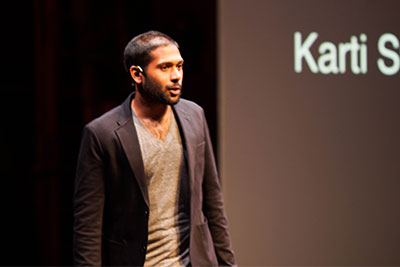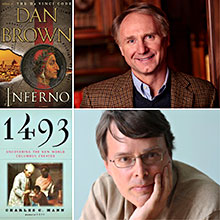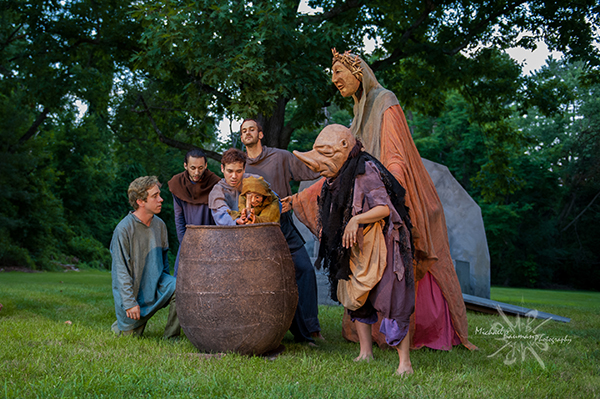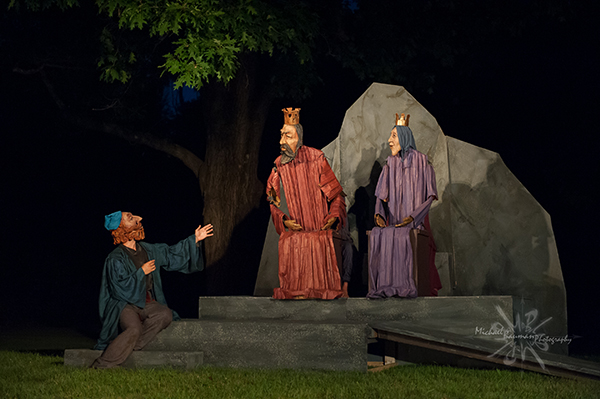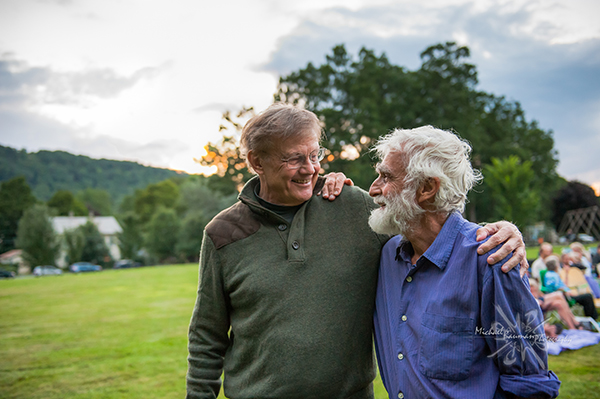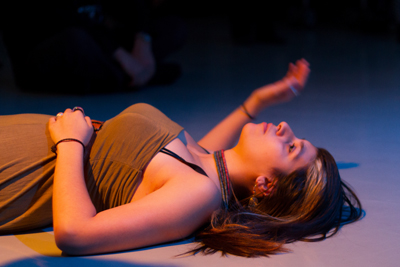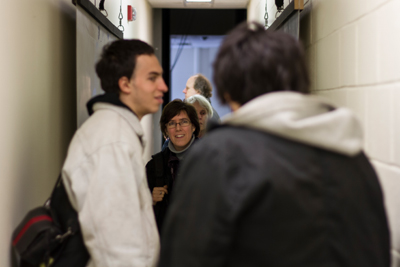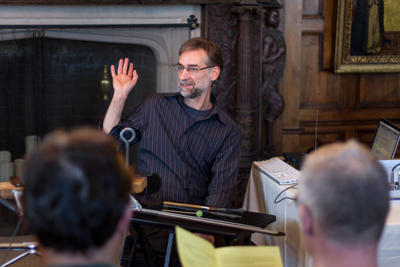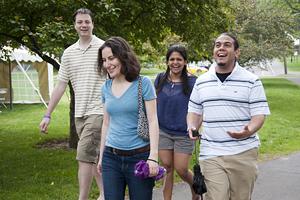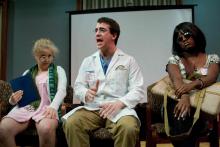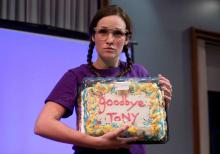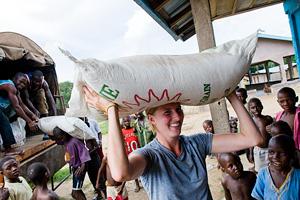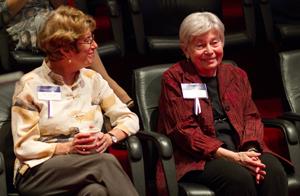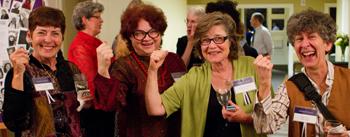Some students flipped burgers. Others interned on Wall Street. Still others traveled near and far to build houses, take pictures or mentor young children. Last week, we posted a message inviting all students to pen a few lines about how they spent their summer vacation. Here are the replies. Please log in (at upper right) to post your own summer-vacation story.
Also: Click here to find out how your favorite professors spent those long ago (or, in some cases, more recent) undergraduate summers.
Charles Quigg ’09
Along with Sam Grausz ’09, Sabrina Dorman ’09 and Josh Nathan ’10, I had a fantastic and enlightening summer working in three remote Sierra Leonean villages for the Sierra Leone Plymouth Partnership (SLPP), a small NGO started by Jeff Hall ’86 and a partner of the CCE’s Citizen Summer Program. During our seven weeks in the villages, we worked to solidify SLPP’s recently started microloan program, expand access to clean water supplies, manage the construction of 150 new latrines and assist in providing excellent educational opportunities to village children, including an SLPP-sponsored summer school program.
Jessica Mestre ’10
Thanks to a Fellowship for Action from the CCE, I spent 10 formative weeks on a public service internship in Montevideo, Uruguay. I worked with an NGO called Un Techo para mi Pais (A Roof for my Country), a youth-run organization, present in 12 countries in Central and South America, that is dedicated to eradicating poverty in Latin America and creating a social conscience among its youth. The group builds emergency housing and implements social development programs in marginalized settlements.
I was there in the middle of their winter campaign, working with the communications department. As a photographer, I coordinated and contributed to a photography installation in cooperation with a local photo club, created to denounce the realities of life in the settlements. Another significant project was the 8-page informational supplement about the organization, which was included in the national newspaper and distributed around the country.
While my time in the office was enjoyable, the most significant part of the experience for me was in the settlements themselves at the construction sites. Each crew consists of 5 or 6 crewmembers (who are typically university students), the crew captain (also a student), and the family members themselves. As you build the house, you also build deep connections with your crewmates and the people who will be living in the house. It is an empowering process for everyone involved. I will never forget sitting on top of the roof as I worked with Aldo to finish his home, or the kind words of appreciation that his wife, Veronica, shared at the ribbon cutting ceremony. I am immensely grateful for the opportunity.
View a gallery of Mestre's photos
Abby Murray ’11
I worked as a National Park Ranger. Yes, I wore the hat. Not to mention the gray and green, itchy, unflattering, soul-smothering uniform. I was sworn into the service of the Department of the Interior on June 22, and felt the enormity of my responsibilities settle onto my shoulders as I repeated my oath, and promised to protect the United States “...from all enemies foreign and domestic....” The oath, the uniform, my badge and special keys—these all made me feel very important.
I soon came to appreciate the subtle differences between rangers from different regions. Though I wore the same hat and took the same oath as rangers in Yosemite and the Grand Canyon, I happened to be working in urban Cambridge, Mass. The Longfellow National Historic Site, although certainly a national treasure, was in no danger of forest fires, and its visitors needed no warnings not to feed the wild animals. My job was completely different from that of a ranger working in an outdoor park: I gave 45-minute tours about the poet Henry Wadsworth Longfellow and the house’s service as George Washington’s headquarters for nice months during the American Revolution.
At the end of the summer, I knew more about Longfellow than I ever thought I would want to know. Sometimes I got sick of him, I’ll admit. But it was a great job, and I’m considering it for next summer as well. My ranger hat, which sits on a lonely shelf in my closet, is calling to me.
Tim Butterfield ’12
After high school graduation, I spent the first week of summer in Northern California with three friends. We stayed at a cabin on Lake Tahoe and spent a few days in San Francisco and Sacramento. As a first-time tourist in San Francisco, I rode the cable cars, toured Alcatraz and visited the Golden Gate Bridge.
After California, I returned home to St. Louis, where I worked as a counselor and lifeguard at a local day camp. I worked every afternoon, playing with kids between the ages of 3 and 9 and enjoying swim time with them! I ran regularly throughout the summer as well, since that is my greatest passion. It was fun to explore new trails and roads in St. Louis as I trained for an upcoming marathon. I am continuing to run and explore here at Amherst.
Destry Sibley ’09
With the support of a CCE Fellowship for Action, I spent two months this summer in Bangladesh as a research intern for Building Resources Across Communities (BRAC), one of the world’s largest development organizations. I worked in the NGO’s economic development department, with a program that targets the poorest demographic in the country, called the “ultra poor.” I used the first four weeks of my visit to interview ultra poor women in rural areas and to construct their narratives into case studies. I wrote the program’s biannual progress report during the next four weeks. So I spent the first month conducting field-based qualitative research and the second half compiling quantitative research in the organization’s central office in Dhaka, Bangladesh’s capital city.
Nicol Zhou ’10
In July, I interned in the corporate/finance department at Rodyk and Davidson in Singapore. That job introduced me to the basics of corporate legal work and gave me a chance to do hands-on work with a number of lawyers at the firm. I attended client meetings, proofread and corrected contracts and studied the business of a corporate lawyer.
After my internship ended, I worked with the Singapore World Schools Debate Team—the team that is representing the country at the Washington, D.C., World Schools Tournament. The World Schools Tournament is the largest international debate competition at the high school level, with 35 to 40 nations represented every year. (In 2007, I served as a judge in the tournament, at the Seoul Worlds.) I trained with the Singapore national team extensively, debating against them in both closed training and public debates, and I was in charge of a few training sessions.
Claire Jen ’10
I hopped on a quick and easy 18-hour flight to Johannesburg, South Africa, where I’m studying abroad this semester at the University of the Witwatersrand. As a participant in the International Human Rights Exchange program (IHRE), I’ve gone to the Apartheid Museum and to Soweto, one of the most politically inflamed townships in South Africa. We traveled to Kruger National Park, spent a few nights at a rural Venda village in Hamakuya and went hiking along the Limpopo River.
I’ve also had the great chance to fly to Victoria Falls, the largest waterfall in the world, in between Zambia and Zimbabwe. In neighboring Botswana, we saw African Wild Dogs and lions on our sunrise safari trip and ended in the evening by watching elephants cross the Zambezi river with the sun setting behind them.
The program also finds a human rights-related internship, and I’ve been fortunate enough to work at the Street Law Project and at ProBono.org. At Street Law, I teach civic education at a high school and conflict resolution at the Johannesburg Prison. At ProBono.org, I work with an attorney picking which cases to take, and while it is tough to judge the merits of each case, it’s rewarding to see the effort and care that goes into each case, both from the ProBono attorney and from the clients.
Coming to South Africa is something I won’t forget in my lifetime—the people, food and culture are all so warm, and I feel quite grateful I’m here. Most striking, there is a sense of general optimism here—there’s a lot of participation and debate in politics, from the student council to the African National Congress, and in the face of some big obstacles South Africa still has to face, its a growing place, and it’s amazing to be here, studying rights in a place that governs itself by a constitution with the most inclusive, broad-reaching equality clause in the world. I can’t wait to (hopefully) come back for the Soccer World Cup in 2010!
Surya Kundu ’09
I spent the summer working with SEED Kolkata, an NGO based in Kolkata (Calcutta), India, to bring education and sustainable change into the lives of children living in the streets, railway platforms and slums of Kolkata.
It was quite an incredible experience, full of bizarre juxtapositions and interesting contrasts. For the majority of my stay, I lived in a flat with some college friends of my father’s. Owning multiple apartments around the city and several cars, each with its own driver, my hosts, who run a very successful shipbuilding business, fell firmly into the category of India’s rising upper-middle class. But every day I’d leave the comfort of their home for the world I was working in. The work with SEED was like a crash course in human life in extreme poverty.
SEED maintains both day protection and night protection shelters for the many lost, abandoned or run-away children living on railway platforms in the city. For the children who can recall where their homes are, SEED attempts to reunite them with their families. For those who are homeless, SEED runs homes where the children are fed, sent to school and nurtured. Additionally, SEED runs community health clinics; trains community health workers; builds wells; and runs adult vocational training schools, nursery schools, tutoring centers, literacy centers and two formal schools near large slum areas.
At the shelter at Howrah Station, for the children living on the platforms, I met 14-year-old girls who had already gotten married and given birth several times, each marriage being a way to get off the platforms for a short time. Other children were addicted to sniffing glue fumes; some had open sores from falling while trying to jump onto trains. It was one of the most heartbreaking places I had ever seen.
I spent a portion of my time visiting the young residents of one of SEED’s boys’ homes. These boys were once the children of the platforms but were now well into their rehab and reintegration into normal society. They were bright, loving and eager to show me their paintings, dance moves and skills at soccer. Most of the boys excelled in their academics and consistently ranked at the top of their class at school.
I ended up creating SEED’s annual report to their donors outlining their projects and introducing their goals for the future. I completely redesigned the layout of the publication, visited each project site, took photos and wrote the entire text of the report. See some of the photos here. In my time off, I explored the city of Kolkata and visited family members in the area.
Nathaniel Hopkin ’10
I spent my summer working and traveling in Uganda. I was working for Educate!, a U.S.- based nonprofit founded by Eric Glustrom ’07 that operates in Uganda. My job involved a lot of the ground work required for an ambitious set of programs that will start next February. The programs center on the observation that the schooling system in Uganda does not do a sufficient job educating students. Everything there focuses on memorization for standardized testing; creativity, initiative and leadership are stifled.
As a much-needed supplement to secondary school education in Uganda, Educate! is partnering with 20 schools throughout the country and offering a course in Socially Responsible Leadership, to be taught by an Educate! mentor. The mentors are Educate! staffers, independent of the schools in which they are placed. All are recent graduates from universities in Uganda, and all will undergo an intensive three-month induction in which they will live together at the Educate! headquarters, learn the curriculum and receive training. The goal is for the mentors to develop close relationships with the students, to act as role models and to provide moral support, encouragement and advice. In addition, each partner school will have an extracurricular club focused on using social entrepreneurship to creatively solve problems in the community. The club, open to all students at each school, will also be moderated by the mentors.
In Uganda, I lived in the Educate! headquarters in a suburban area outside the country’s capitol city, Kampala. My ultimate goal was to find four schools from diverse religious and socioeconomic backgrounds for Educate! to partner with. In addition, I helped review applications for the mentor jobs.
A highlight of the trip was a visit to the refugee camp in which Educate! got its start. We spent a week living there with one of the students whom Educate! sponsors. It was inspiring to see how well people adapted to their displacement, and to see people from a diverse array of cultures and nationalities, all undergoing hardship and stress, living near each other in such harmony. Equally amazing was the hard work and optimism that was almost universal among the refugees.


